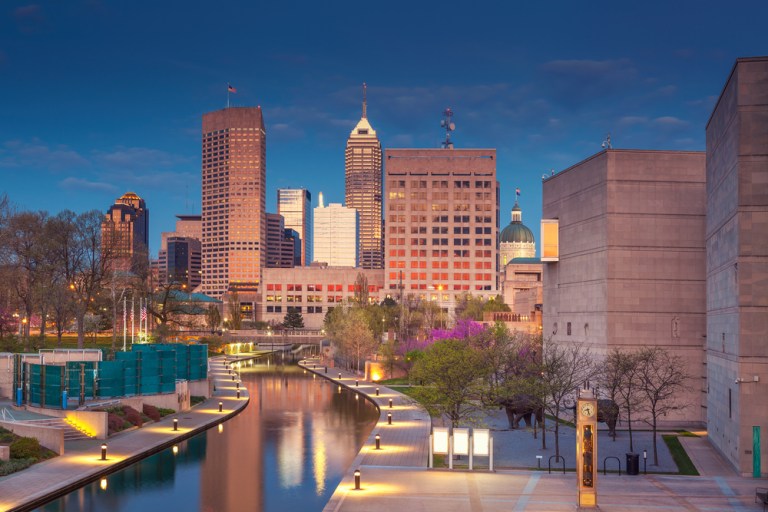
Situated between Cincinnati, Ohio and Chicago, Illinois, Indianapolis, is more than just the capital of Indiana.
Over the course of the last few years, Indianapolis has slowly built up its technology industry. Ian Nicolini, from the city’s economic development agency, Develop Indy, shared with The New York Times earlier this year that of the 3,700 jobs to be added in Indianapolis in 2016, two-thirds were directly from the tech sector. This is up from the one-fifth of 4,000 jobs from the prior year. What may be a contributing factor here is the fact that the city has a nonprofit, TechPoint, that’s developing tech internships for new college graduates, which likely helps retain most of the young talent after graduation.
In this week’s Tech Center tracker, Angie Hicks, CMO and cofounder of Angie’s List, spoke with PYMNTS about Indianapolis’ up-and-coming tech scene and how the city is leading various initiatives to help continue on its path of success.
Before we jump into the post, here are a few quick facts about Indianapolis and its tech scene:
Following Salesforce’s acquisition of Indianapolis-based ExactTarget back in 2013, more tech companies began to follow suit. Companies like Angie’s List, Interactive Intelligence and Kronos have flocked to either open up offices or start their headquarters in Indianapolis. Angie Hicks, CMO and co-founder of Angie’s List, a website with crowd-sourced reviews of local businesses, spoke with PYMNTS about the burgeoning tech scene in Indianapolis.
Here’s an excerpt of the conversation:
PYMNTS: Can you describe your personal and/or professional experience with the tech community in Indianapolis?
AH: I’m the CMO and cofounder of Angie’s List, a company begun in suburban Columbus, Ohio, but headquartered in Indianapolis since 1996. We work very closely with the Indy tech community, in part to help develop a great pipeline of new talent that we can use and in part to encourage that for our corporate peers and the local economy. I’m also a cofounder of the Governor Bob Orr Entrepreneurial Fellowship, which has worked since 2002 to develop and keep in Indiana the best and brightest young minds.
PYMNTS: What do you think makes Indianapolis (or Indiana as a whole) an attractive location for both entrepreneurs and investors? Is there anything people may find surprising about operating a business there?
AH: Indiana is a great place for tech because the people who live here actually WANT to be here. They might have been lured by the coasts when they were starting out, but when it comes time to start a family, we see folks either coming home or relocating for our low cost of living and high quality of life. It’s also a great place for people in tech to come because there’s such a huge potential to get in with a new young, tech company on the ground floor and grow with it.
I think if you’re not from the Midwest, you may be surprised by how smart, nice and hard-working the majority of people are here. Don’t give in to that “fly-over state” kind of dismissiveness. It’s a mistake. There are tons of great universities and entrepreneurs here.
PYMNTS: How does the startup and tech scene in Indianapolis differ from other cities in the United States?
AH: The startup scene is much more collaborative in Indianapolis than you’ll find in other parts of the country. The battle for talent is as intense here as anywhere you’ll find, but that doesn’t prevent startups and well-established companies from actively assisting one another when needed.
We have an emerging tech scene that is sure to enable recent startups/scale-ups. So,I’d say we’re on the cusp of great opportunity, which is really exciting for people with ambition and the heart to create and sustain a business. We work on cultivating tech talent in a variety of ways. We have key people involved in great outreaches like the Indy Women in Tech Championship, which is a Guggenheim/local initiative focused on women in tech; the Teacher Tech Connect initiative that focuses on helping local educators learn what tech jobs are so they can shepard students; and a ton of other programs that bring STEM opportunities to kids and hackathons that encourage adults as well as kids to get into tech.
PYMNTS: What are some of the challenges facing startups in Indianapolis? Are there any initiatives to help address those barriers?
AH: Getting national attention on what we do, which can result in capital and talent being drawn here. The success of companies that have raised venture capital, IPO and growth isn’t an initiative per se, but it begets attention, investment and more success. We have a number of great initiatives like TechPoint Indiana and General Assembly’s bill to create a VC fund for investing in Indiana companies.
PYMNTS: How has Indianapolis’ startup ecosystem changed in recent years? What do you think has sparked this transformation?
AH: My guess would be the series of successful business outcomes that have happened over the past few years has created buzz. With more capital, there’s been an increase in startups, which has attracted more talent and more capital. We really have a great startup ecosystem.
PYMNTS: Which sectors of the technology landscape are thriving in Indianapolis? How do you see these industries evolving in the coming years?
AH: Marketing tech, health tech and security tech are the main niches where Indiana is expanding, but we’re also seeing great expansion in our legacy industries of manufacturing, logistics and life sciences.
The marketing tech companies in the city include Sigstr, Torchlite, SmarterHQ, DemandJump, Emarsys, and Salesforce Marketing Cloud, while the health companies include Diagnotes, Perceivant, Springbuk and Policy Stat. The security tech companies in the area of note are Rook Security and Pondurance.
PYMNTS: Is there anything else you think people should know about Indianapolis’ role as a global tech center?
AH: I think I’d leave you with a strong invitation to check us out. Indiana and Indianapolis are great, thriving and welcoming communities full of smart and helpful people.